Education cooperation facilitates integration

Wong Tang-Tat, principal of the Hong Kong curriculum of Shenzhen Hong Kong Pui Kiu College Longhua Xinyi School. Courtesy of the interviewee
Wong Tang-Tat, principal of the Hong Kong curriculum of Shenzhen Hong Kong Pui Kiu College Longhua Xinyi School, compares the opening and operation of his school in Shenzhen to sowing a seed of Shenzhen-Hong Kong cooperation in the education field Tuesday, a week ahead of the end of the first school year at the school in Longhua’s core area.
Wong said his school tries to make a difference with the big picture of Shenzhen-Hong Kong and even the Guangdong-Hong Kong-Macao Greater Bay Area (GBA) integration at a “micro level,” which might eventually set examples for Hong Kong educators and unite people with different backgrounds to appreciate what the nation has offered its citizens.
“We want to leverage the strength of both Hong Kong and the mainland curriculum at the school, offering both for students to choose from based on their conditions while highlighting our English language advantage,” Wong said.
“We are allowed to make such an educational trial by offering Hong Kong curriculum especially for Hong Kong families based in the Greater Bay Area thanks to the Shenzhen government, which keeps an open mind.”
Wong said they encourage in-depth exchange between Hong Kong and mainland faculty members and students in the school as integration takes time and must go through a process of “recognition, understanding, acceptance, inclusiveness and then participation and practice.”
“I always encourage my students to travel across the country to learn more about it and then enhance their sense of being Chinese. We will respond accordingly to the country’s need and we try to share our Shenzhen-Hong Kong cooperation experience through various organizations and our sister schools,” he said.
Wong added that he felt empowered by his job because being involved in this educational trial and starting anew on the mainland are both a challenge and mission for him.
“Hopefully we’ll not only help improve the education service in the GBA, but also offer experiences for other educators in the rest of the country,” he said.
The school opened to students last September as Wong and his team saw an increased demand for education among Hong Kongers moving to the mainland in recent years.
The school enrolled about 1,300 primary and middle school students, with 1,000 of them receiving Hong Kong curriculum education.
So far, the school has around 150 faculty members, over 70 among them are Hong Kong residents.
The second and third phases of the school are under construction. In the future, it will provide education from kindergarten through senior high school.